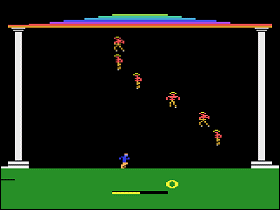 The Game: Jason, having made off with the Golden Fleece, has enraged the gods, who trap him in a temple along with a never-ending supply of Furies. Players can move Jason from side to side to avoid the Furies’ fire, and to fire back – but shooting a Fury directly will create another Fury rather than destroying it. Carefully-timed shots at the temple’s roof, however, will dislodge bricks that can permanently eliminate any Furies that they hit. Jason (and, presumably, countless screaming Argonauts) will advance a level when all of the Furies on the present level are destroyed. Taking too much damage from the Furies (or from chunks of the roof that he himself has caused to fall) will cost Jason his life. (Imagic, 1983)
The Game: Jason, having made off with the Golden Fleece, has enraged the gods, who trap him in a temple along with a never-ending supply of Furies. Players can move Jason from side to side to avoid the Furies’ fire, and to fire back – but shooting a Fury directly will create another Fury rather than destroying it. Carefully-timed shots at the temple’s roof, however, will dislodge bricks that can permanently eliminate any Furies that they hit. Jason (and, presumably, countless screaming Argonauts) will advance a level when all of the Furies on the present level are destroyed. Taking too much damage from the Furies (or from chunks of the roof that he himself has caused to fall) will cost Jason his life. (Imagic, 1983)
Memories: One of the lesser-known Imagic titles for the 2600, No Escape! was titled Escape From Argos for much of its development cycle. It combines the tried-and-true elements of slide-and-shoot games and brick-busting games such as Breakout, but does it in such a novel way that it manages to be fresh.
 As usual with games from Imagic and Activision, No Escape is impressive for its almost complete lack of on-screen “flicker”; the sound effects, though simple, are impressive here too, with the repetitious echoing droning sounds contributing to the overall “trapped” feeling of the game. It’s almost but not quite music.
As usual with games from Imagic and Activision, No Escape is impressive for its almost complete lack of on-screen “flicker”; the sound effects, though simple, are impressive here too, with the repetitious echoing droning sounds contributing to the overall “trapped” feeling of the game. It’s almost but not quite music.
The game’s evolving difficulty level makes strategy important; early on, it’s a clumsy mistake to directly shoot a Fury and thus create two enemies where there was previously only one. In later levels, it’s a deadly inevitability. As the game progresses, the Furies get wise to the brick-dropping strategy, and even firing constantly at the roof to rain down death upon the Furies will no longer work (it will, in fact, work against the player, wasting valuable ammo). Starting around the fourth level, No Escape! gets really interesting.
 No Escape! languishes in an unearned obscurity next to the Imagic games that everybody knows (i.e. Demon Attack and Atlantis), but as 2600 games go, it’s maddeningly fun – this game deserves more recognition than it likely got back in the day, at the dawn of the industry crash.
No Escape! languishes in an unearned obscurity next to the Imagic games that everybody knows (i.e. Demon Attack and Atlantis), but as 2600 games go, it’s maddeningly fun – this game deserves more recognition than it likely got back in the day, at the dawn of the industry crash.
 using WordPress and
using WordPress and